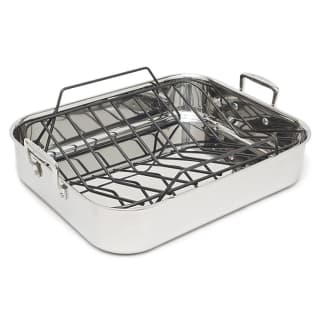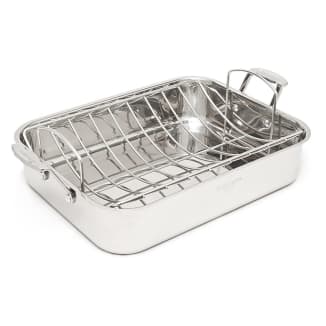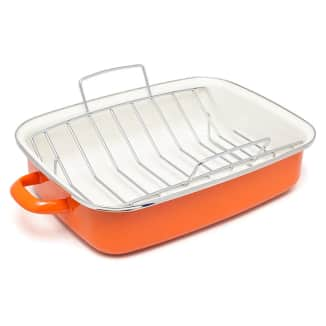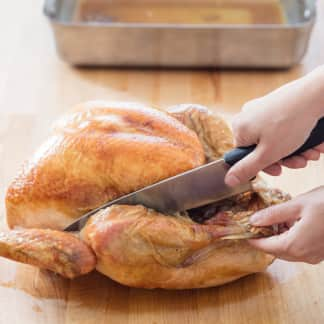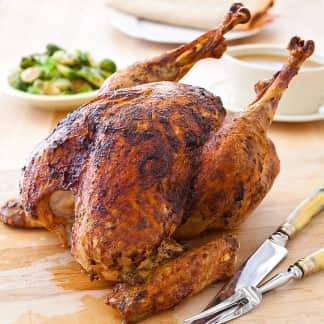The best roasting pans are made from fully clad stainless steel; have large, flat cooking surfaces; and are easy to lift and maneuver. They also come with racks that fit snugly within the walls of the pan. Our favorite is the Cuisinart Multiclad Pro Triple Ply Stainless Cookware 16" Roasting Pan with Rack. It’s a pleasure to use and can accommodate 20-pound turkeys and smaller roasts easily.

A handsome, heavy-duty roasting pan bearing a big holiday roast—what could be more iconic? While we don’t break these pans out every day, they’re essential when you’re cooking for a crowd. Roasting pans have two major advantages. First, they have big cooking surface areas, making it easy to sear and roast large cuts of meat (turkey, pork shoulder, prime rib). Sure, for some roast recipes, a baking sheet will serve you just fine—it has an even larger cooking surface area. But it lacks the second advantage that roasting pans have: relatively tall sides. These sides let you pile the pan a little higher with food without any risk of it falling overboard, which makes roasting pans great for cooking several foods simultaneously—a roast rack of pork with potatoes and vegetables or a turkey breast with stuffing, for example—or cooking large batches of mussels and paella on the grill, among other tasks.


Roasting pans are great not only for roasting large cuts of meat and turkey but also for any food that requires a lot of surface area, such as our paella on the grill.
We often use them with roasting racks, and for this reason we largely prefer models that come with their own dedicated racks. Racks help elevate your roast above the pan surface so that hot air can circulate around the roast and help it cook evenly. Most of the models we’ve tested have racks, though an outlier came without one; it can be used with a standard wire rack, which does the same job as a V- or U-shaped roasting rack.
What Size Roasting Pan Should You Get?
We think a roasting pan measuring at least 16 inches long and 12 inches wide is the best option for most home cooks. These give you plenty of room to easily accommodate large prime rib roasts and 20-pound turkeys.
For small cuts of meat and poultry, such as a roast beef or whole chicken, you can often get by with a 12-inch stainless-steel skillet. But if you’d like a smaller roasting pan instead, check out our guide to these more diminutive models.

What to Look For
- Fully Clad Stainless Steel: Roasting pans come in many different materials. We prefer stainless steel that is “fully clad,” meaning that it has a layer (or layers) of aluminum in between layers of stainless steel. The aluminum quickly conducts heat, while the stainless steel retains heat well. Fully clad pans are thicker and heat more slowly than thin stainless-steel and enamel-coated steel pans. They’re heavier and more expensive as well. But they heat more evenly and are more durable, resisting warping more readily than pans made from these other materials. Roasting pans made from a single layer of thick stainless steel can also be durable, but they don’t conduct heat as well as fully clad steel, making them a secondary choice in our book.

- Moderate Weight: The less a pan weighs, the easier it is to move and maneuver, especially when laden with the extra weight of a big roast. While fully clad pans can be heavy, we preferred those that were slightly less so than others, with a weight under 7 pounds including the rack. Truly lightweight pans were more likely to warp, and heavier pans were more of a burden to lift.
- Flat Cooking Surface: We liked pans with flat cooking surfaces, as these made it easiest to sear large pieces of meat or roast more vegetables evenly. Models with grease troughs around the perimeter of the pan limited the cooking surface area available for searing and were harder to deglaze. They also made it harder to roast vegetables evenly—potato chunks couldn’t sit level across the entire surface, and oil pooled in the troughs instead of extending across the surface of the pan.

- Big Upward-Facing Handles: Big handles were easier for hands of all sizes to grab, making it easier to transport the pans in and out of the oven. We also preferred handles that faced upward to those that faced outward, as they kept our hands farther from the hot oven walls and made it less likely that we’d accidentally burn ourselves.

- Snug-Fitting Racks: We liked racks that fit closely inside the roasting pans they came with. These kept our roast turkeys and pork loins from shifting around as we moved the pan from stovetop to oven and back.


Snug-fitting racks (left) don’t shift around when you move your roasting pan in and out of the oven. Loose-fitting racks (right) can be more precarious, threatening to send your roast flying in transit.
What to Avoid
- Thin Enamelware and Stainless-Steel Pans: Pans made from thinner metals are more likely to warp when you heat them on the stovetop to sear meat or deglaze for pan sauces. The enamel on enamelware pans we’ve tested has burned and cracked over high heat, too, rendering them useless.
The Tests
- Roast 20-pound turkey
- Sear and roast Cider-Glazed Roast Pork Loin
- Roast 2 pounds potatoes
How We Rated
- Performance: We rated the pans on how well food turned out: how evenly food roasted and browned and how deeply meats were seared.
- Ease of Use: We rated the pans on how easy they were to lift and maneuver and on how well their corresponding racks fit, where applicable.
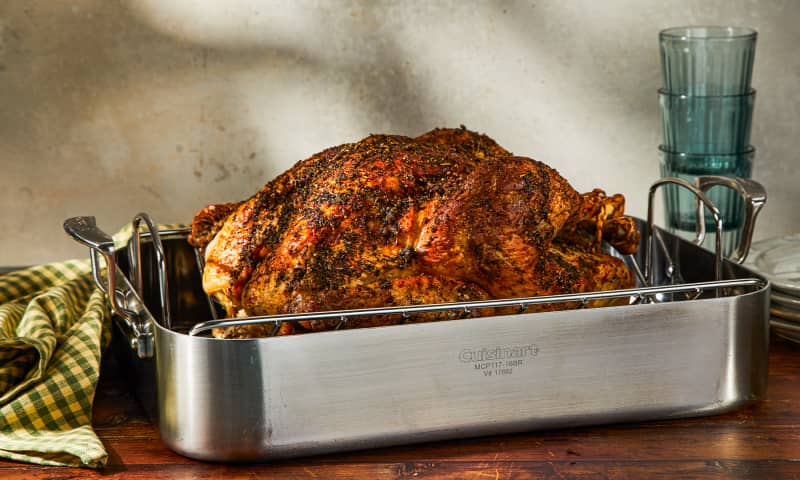
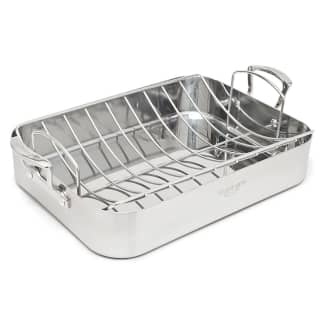


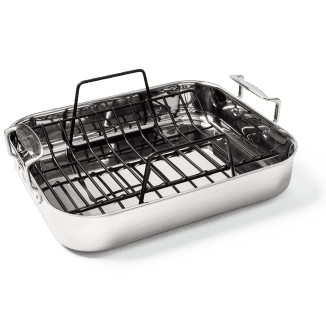

 Buy at Williams Sonoma
Buy at Williams Sonoma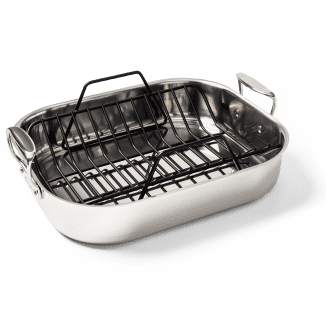

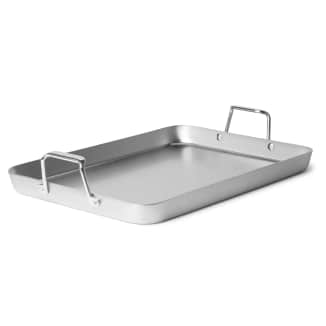
 Buy at Misen
Buy at Misen

